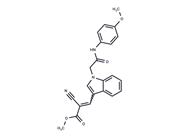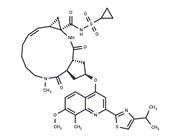| Name | AMAROGENTIN |
| Description | Amarogentin is mainly extracted from Swertia and Gentiana roots. It plays cemopreventive/therapeutic role during liver carcinogenesis through modulation of cell cycle and apoptosis |
| Kinase Assay | The computer-aided drug discovery methods were used to unravel the COX-2 inhibitory mechanism of Amarogentin and to check its selectivity for the inducible isoform over the constitutive one.?The generated theoretical models of both isoforms were subjected to molecular docking analysis with Amarogentin and twenty-one other Food and Drug Authority (FDA) approved lead molecules.?The post-docking binding energy profile of Amarogentin was comparable to the binding energy profiles of the FDA approved selective COX-2 inhibitors.?Subsequent molecular dynamics simulation analysis delineated the difference in the stability of both complexes, with Amarogentin-COX-2 complex being more stable after 40ns simulation.?The total binding free energy calculated by MMGBSA for the Amarogentin-COX-2 complex was -52.35 KCal/mol against a binding free energy of -8.57 KCal/mol for Amarogentin-COX-1 complex, suggesting a possible selective inhibition of the COX-2 protein by the natural inhibitor.?Amarogentin achieves this potential selectivity by small, yet significant, structural differences inherent to the binding cavities of the two isoforms.?Hypothetically, it might block the entry of the natural substrates in the hydrophobic binding channel of the COX-2, inhibiting the cyclooxygenation step[1]. |
| In vivo | Amarogentin, a bitter secoiridoid glycoside from S. chirayita, shows varied activity in several patho-physiological conditions, predominantly in leishmaniasis and carcinogenesis.?Experimental analysis has revealed that Amarogentin downregulates the cyclooxygenase-2 (COX-2) activity and helps to curtail skin carcinogenesis in mouse models;?however, there exists no account on selective inhibition of the inducible cyclooxygenase (COX) isoform by Amarogentin[1].marogentin inhibits the growth of SNU-16 human gastric cancer cells (IC50 = 12.4 μM after 48 hours) and increases apoptosis when used at a concentration of 50 μM. Amarogentin (10-50 mg/kg, s.c.) dose-dependently reduces tumor growth in a SNU-16 nude mouse xenograft model[2]. |
| Storage | keep away from direct sunlight | Powder: -20°C for 3 years | In solvent: -80°C for 1 year | Shipping with blue ice. |
| Solubility Information | DMSO : 2 mg/mL (3.4 mM)
|
| Keywords | Apoptosis | AMPK | AMP-activated protein kinase | Inhibitor | inhibit | AMAROGENTIN |
| Inhibitors Related | Stavudine | 5-Fluorouracil | Myricetin | Sodium 4-phenylbutyrate | L-Ascorbic acid | Dextran sulfate sodium salt (MW 4500-5500) | Metronidazole | Sorafenib | Tributyrin | Chitosan oligosaccharide |
| Related Compound Libraries | Anti-Tumor Natural Product Library | Terpene Natural Product Library | Bioactive Compound Library | Traditional Chinese Medicine Monomer Library | Selected Plant-Sourced Compound Library | Saccharide and Glycoside Natural Product Library | Antiparasitic Natural Product Library | Neuroprotective Compound Library | Anti-Aging Compound Library | Anti-Cancer Active Compound Library |

 United States
United States



